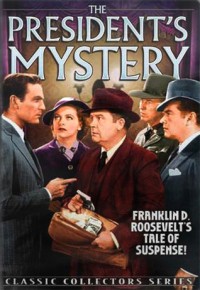The President's Mystery Plot
 President Franklin Delano Roosevelt once came up with his own idea for a mystery novel. He told magazine editor Fulton Oursler that he'd been carrying around in his mind the plot for a mystery novel for years. His idea? "How can a man disappear with five million dollars in any negotiable form and not be traced?" Oursler suggested they ask the leading writers in the U.S. to collaborate on such a story, to which FDR replied, "Go ahead. See what you can all do with it."
President Franklin Delano Roosevelt once came up with his own idea for a mystery novel. He told magazine editor Fulton Oursler that he'd been carrying around in his mind the plot for a mystery novel for years. His idea? "How can a man disappear with five million dollars in any negotiable form and not be traced?" Oursler suggested they ask the leading writers in the U.S. to collaborate on such a story, to which FDR replied, "Go ahead. See what you can all do with it."Oursler did just that, contacting various authors and challenging them to take "the President's mystery plot" and contribute a chapter to the story by plonking the protagonist, Jim Blake, in a dire situation and then leaving him for the next author in line. The work of the first authors, Rupert Hughes, Samuel Hopkins Adams, Anthony Abbot, Rita Weiman, S. S. Van Dyne, and John Erskine, were serialized in Oursler's Liberty Magazine in 1935, and the book was published in 1936. However, poor Jim Blake was left hanging for thirty years until Erle Stanley Gardner (creator of Perry Mason) came along and tied everything up in a final chapter when the book was reprinted in 1967 and retitled The President's Mystery Plot.
More a literary curiosity than high literature, the book has a bit of camp and zaniness, and true mystery fans may be disappointed in the thin, zigzagging plot and weak characterizations that sometimes accompany collaborative ventures. Still, it was popular enough that a movie was made of the story in 1936, directed by Phil Rosen and starring Henry Wilcoxon as hapless Jim Blake (Marc Antony in Cecil B. DeMille's Cleopatra). It's an interesting period piece, if you can get past the first chapter. Writer Rupert Hughes gave Blake a scheming Russian wife and writes out her dialogue with "phoenetic precision," as Arthur Schlesinger, Jr., aptly notes in his introduction ("Jeem, how you can't see it is beecose I loaf you so dear I cannot deevide your loaf with even some babies?").
More telling may be what the book reveals about Roosevelt himself. When he proposed the idea to Oursler, the hero was conceived as "hating the falsity of his existence, the meaninglessness of his career, the sameness of his middle-aged routine, the absence of purpose and the boredom with his marriage."
 1
1



